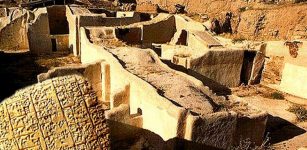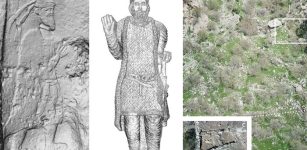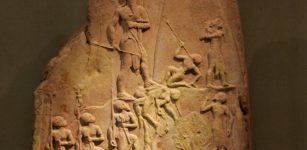The Mystery Of Ancient Ever-Burning Lamps
Ellen Lloyd - AncientPages.com - Imagine that you find a small burning lamp hidden deep in an ancient vault. This mysterious lamp, which is in perfect preservation, has burned continuously without fuel for the last 2,000 years. What would you think of your remarkable discovery?
Most likely, you would wonder whether the precious lamp you hold in your hands is a magical object, a work of God, or perhaps some evil power.
Could this ancient treasure be proof of highly advanced technology? Did our ancestors discover the secret of eternal light?
Credit: Adobe Stock - John
"Now the House of Solomon the King was illuminated as by day, for in his wisdom he had made shining pearls which were like unto the sun, the moon and the stars in the roof of his house. " (From: "The Queen of Sheba and Her Only Son Menyelek")
Although it might sound amazing, and for some even impossible, certain extraordinary findings clearly show that perpetual light was relatively common in prehistory.
During the Middle Ages, several ever-burning lamps were discovered in ancient tombs and temples. Ancient records show that these mysterious objects were found worldwide in India, China, South America, North America, Egypt, Greece, Italy, the United Kingdom, Ireland, France, and many other countries.
Unfortunately, looters, vandals, and superstitious diggers who feared that these objects possessed supernatural powers destroyed many of the lamps.
As we all know, the Middle Ages cannot be characterized as a particularly scientific period. It was a dark time for those who persuaded knowledge. Still, curiosity is a part of human nature, and questions were asked.
How were the ancients able to produce lamps that could burn without fuel for hundreds and, in some cases, thousands of years? From whom did our ancestors gain their secret knowledge?
Naturally, the subject of perpetual light quickly became controversial, and the opinions of the authorities were divided.
Some authors rejected the idea of a never-ending flame despite the evidence they were confronted with. A small group of more open-minded and enlightened persons confirmed the existence of if not eternal, at least very long-lasting light. Many, on the other hand, accused the Pagan priests of performing clever tricks.
However, most "learned" men acknowledged the unusual findings and declared the perpetual lamp a devil's work.
This was a common explanation in the Dark Ages. As soon as something was unknown, of Pagan origin or not, by the rules set by the early Roman Church, it was labeled as an invention of the dark forces, the devil, and his demons.
Some speculated that secret Hebrew societies had preserved what is now known as electricity. For example, the occult writer Eliphas Levi relates a curious story in his book "Historie de la Magie."
He tells of a certain mysterious French rabbi named Jechiele, who was an advisor in the thirteenth-century court of Louis IX. Apparently, Jechiele owned a lamp that he used to place in front of his house for everyone to see.
The "dazzling lamp that lightened itself" possessed no oil or wick. When the rabbi asked about the energy source, he always said it was a secret. Jechiele experimented quite a lot with electricity. To protect himself from enemies, he invented a discharge button that sent an electric current into the iron knocker on his door. It is written that when Jechiele "touched a nail driven into the wall of his study, a crackling bluish spark immediately leaped forth. Woe to anyone who touched the iron knocker at that moment; he would bend double, scream as if he had been burned, then he would run away as fast as his legs could carry him."
There were numerous speculations regarding the perpetual lamps' secret energy source. During the Middle Ages and later, many great thinkers tried to solve the problem of preparing fuel that renewed as quickly as it consumed. However, none of the experiments conducted were genuinely successful. It turned out impossible to produce a copy of an ever-burning lamp. The ancients' technology remained unknown.
The earliest accounts of a divine flame, an eternal light source, can be found in various mythological texts. The descriptions of the eternal flame considered a part of the divine fire, are closely connected with the gods. The Greek god Prometheus was punished for giving fire to mankind.
Credit: Adobe Stock - Adin
The secret of the eternal flame was regarded as the gods' sole property. Knowledge of eternal light should not be passed on to humans. Nevertheless, some gods disobeyed and revealed their divine secret to humanity. When humans learned to produce perpetual light, temples worldwide were equipped with eternal altar flames.
According to the ancient Egyptian, Greek, and Roman traditions, a dead person might need some light on his or her road to the Valley of the Shadow. Therefore, before the tomb was sealed, it was accustomed to place an ever-burning lamp inside. The lamp served as an offering to the god of the dead, and it kept evil spirits away. Its light also offered the deceased the required guidance on the journey to the Underworld.
Hundreds of years later, excavators found the lamps in perfect condition when vaults were opened and still burning.
So far, we have only spoken in general terms about the existence of perpetual light in antiquity. It has been estimated that as many as 170 medieval authors have written about the phenomenal and mysterious ever-burning lamps. Let us now look at some of the remarkable discoveries.
Plutarch wrote of a lamp that burned over the door of a temple to Jupiter Ammon. According to the priests, the lamp remained alight for centuries without fuel, and neither wind nor rain could put it out.
St. Augustine described an Egyptian temple sacred to Venus with a lamp that wind and water could not extinguish. He declared it to be the work of the devil.
In 527 A.D., at Edessa, Syria, during the reign of emperor Justinian, soldiers discovered an ever-burning lamp in a niche over a gateway, elaborately enclosed to protect it from the air. According to the inscription, it was lit in 27 A.D. The lamp had burned for 500 years before the soldiers who found it destroyed it.
In 140, near Rome, a lamp was found burning in the tomb of Pallas, son of King Evander. The light, which had been alight for over 2,000 years, could not be extinguished by ordinary methods. It turned out that neither water nor blowing on the flame stopped it from burning. The only way to extinguish the remarkable flame was to drain off the strange liquid in the lamp bowl.
 Credit: Adobe Stock - Web
Credit: Adobe Stock - Web
In about 1540, during the Papacy of Paul III, a burning lamp was found in a tomb on the Appian Way in Rome. The tomb was believed to belong to Tulliola, the daughter of Cicero. She died in 44 B.C. The lamp burned in the sealed vault for 1,550 years was extinguished when exposed to the air. Interestingly, this particular discovery is also the unknown transparent liquid in which the deceased was floating. By putting the body in this liquid, the ancients managed to preserve the corpse in such a good condition that it appeared as if death had occurred only a few days ago.
When King Henry VIII broke away from the Catholic Church in 1534, he ordered the dissolution of monasteries in Britain, and many tombs were plundered. In Yorkshire, a burning lamp was discovered in the tomb of Constantius Chlorus, father of the Great Constantine. He died in 300 A.D., and the light had been burning for over 1,200 years.
In France, near Grenoble, in the mid-seventeenth century, a young Swiss soldier accidentally stumbled upon the entrance to an ancient tomb. Unfortunately, the young man did not discover the golden treasures that he thought might be hidden inside. Still, his surprise must have been just as big when confronted with a burning glass lamp. Du Praz, the soldier's name, removed the mysterious lamp from the sealed grave and carried it to a monastery. He showed his remarkable discovery to the astonished monks, and the lamp remained at the monastery. It burned for several months until an elderly monk dropped it and destroyed it.
Certain discoveries indicate that the ancients wanted to preserve their knowledge secret. In his notes to St. Augustine, 1610, Ludovicus Vives writes about a lamp found in his father's time, in 1580 A.D. According to the inscription, the lamp was burning for 1,500 years, however when it was touched it fell into pieces. Ludovicus Vives did not share some of St. Augustine's views. He considered perpetual lamps an invention of wise and skilled men, not the devil.
Were the Rosicrucians familiar with the secrets of eternal light?
It would seem so. When the tomb of Christian Rosenkreuz, alchemist and founder of the Rosicrucian Order, was opened 120 years after his death, a shining lamp was found inside.
Another interesting case occurred in England, where a mysterious and unusual tomb was opened. It was believed that the sepulcher was a Rosicrucian. A man who discovered the tomb noticed a burning lamp hanging from the ceiling, lighting up the underground chamber. As the man took steps forward, a certain part of the floor moved with his weight. At once, a seated figure in armor started to move. The figure rose to its feet and hit the lamp with some sort of a weapon. The precious lamp was destroyed. The goal had been accomplished; the lamp's substance remained a secret.
The discoveries I mention in this article are only a small representation of all remarkable findings worldwide. Who knows how many more lamps are still burning, hidden in ancient vaults, undiscovered, and protected from the outside world?
The ancients were familiar with perpetual light. As Eliphas Levi points out: "it is certain that the Zoroastrian Magi had means of producing and directing electric power unknown to us."
Yes, indeed and the ancient Egyptians, Greeks, Romans, and other cultures possessed the same knowledge.
King Solomon was a wise man when he wrote:
"… there is no new thing under the sun. Is there anything whereof it may be said, See this is new? It hath been already of old time which was before us."
First version of this article was published on April 24, 2014
Written by - Ellen Lloyd – AncientPages.com
Copyright © AncientPages.com All rights reserved. This material may not be published, broadcast, rewritten or redistributed in whole or part without the express written permission of AncientPages.com
More From Ancient Pages
-
 Controversial Discovery : 15,000 Ancient Ebla Tablets Prove Old Testament To Be Accurate
Archaeology | Oct 5, 2015
Controversial Discovery : 15,000 Ancient Ebla Tablets Prove Old Testament To Be Accurate
Archaeology | Oct 5, 2015 -
 Aqrabuamelu – Mysterious Scorpion Men In Babylonian Mythology
Featured Stories | Jan 19, 2016
Aqrabuamelu – Mysterious Scorpion Men In Babylonian Mythology
Featured Stories | Jan 19, 2016 -
 Evidence Of Rare Roman-Celtic Temple Near Lancaster Castle
Archaeology | Mar 9, 2023
Evidence Of Rare Roman-Celtic Temple Near Lancaster Castle
Archaeology | Mar 9, 2023 -
 Obscure History Of Skara Brae – Home To Dwarfs
Featured Stories | Apr 12, 2017
Obscure History Of Skara Brae – Home To Dwarfs
Featured Stories | Apr 12, 2017 -
 Lusatian Culture: Ancient Traders Of Central Europe Built Strongly Fortified Settlements To Withstand Scythian Attacks
Civilizations | Jan 27, 2024
Lusatian Culture: Ancient Traders Of Central Europe Built Strongly Fortified Settlements To Withstand Scythian Attacks
Civilizations | Jan 27, 2024 -
 Mysterious 2,000-Year-Old Lost City Of Natounia May Have Been Found!
Archaeology | Jul 20, 2022
Mysterious 2,000-Year-Old Lost City Of Natounia May Have Been Found!
Archaeology | Jul 20, 2022 -
 Extraordinary Gold Pendant With Cross Re-Writes Anglo-Saxon History – It’s One Of The Oldest Symbols Of Christianity Ever Found In East Anglia
Archaeology | Dec 11, 2017
Extraordinary Gold Pendant With Cross Re-Writes Anglo-Saxon History – It’s One Of The Oldest Symbols Of Christianity Ever Found In East Anglia
Archaeology | Dec 11, 2017 -
 Seven Times People Discovered The Americas And How They Got There
Featured Stories | Sep 9, 2022
Seven Times People Discovered The Americas And How They Got There
Featured Stories | Sep 9, 2022 -
 Cursed Magical Dainsleif Sword Of King Hogni And Legendary Battle That Continues Until The Coming Of Ragnarok
Featured Stories | Jul 21, 2018
Cursed Magical Dainsleif Sword Of King Hogni And Legendary Battle That Continues Until The Coming Of Ragnarok
Featured Stories | Jul 21, 2018 -
 Easter Island’s Society Was Sophisticated And Its People Shared Information And Collaborated
Archaeology | Aug 14, 2018
Easter Island’s Society Was Sophisticated And Its People Shared Information And Collaborated
Archaeology | Aug 14, 2018 -
 Mysterious Maya Snake Kings And Their Powerful Kingdom In The Jungle Reveal More Ancient Secrets
Civilizations | Apr 23, 2018
Mysterious Maya Snake Kings And Their Powerful Kingdom In The Jungle Reveal More Ancient Secrets
Civilizations | Apr 23, 2018 -
 5,000-Year-Old DNA Could Solve The Mystery Of Genetic Changes In Europe
Archaeology | Mar 8, 2022
5,000-Year-Old DNA Could Solve The Mystery Of Genetic Changes In Europe
Archaeology | Mar 8, 2022 -
 ‘Tonina Chiapas’ Mayan Pyramid In Southern Mexico Is Among The Largest Yet Found
Civilizations | Oct 29, 2018
‘Tonina Chiapas’ Mayan Pyramid In Southern Mexico Is Among The Largest Yet Found
Civilizations | Oct 29, 2018 -
 Feud Between The Medici And The Borgia Families – What Caused The Renaissance Clash?
Featured Stories | Mar 5, 2019
Feud Between The Medici And The Borgia Families – What Caused The Renaissance Clash?
Featured Stories | Mar 5, 2019 -
 Why Does The Inner Ear Of Neanderthals Pose An Evolutionary Riddle?
Evolution | Feb 20, 2025
Why Does The Inner Ear Of Neanderthals Pose An Evolutionary Riddle?
Evolution | Feb 20, 2025 -
 Mysterious White Chinese May Be Related To Ancient Roman Soldiers – Did Marcus Crassus’ Army Settle Down In The Gobi Desert?
Civilizations | Dec 29, 2017
Mysterious White Chinese May Be Related To Ancient Roman Soldiers – Did Marcus Crassus’ Army Settle Down In The Gobi Desert?
Civilizations | Dec 29, 2017 -
 Did Climate Change End The Akkadian Empire?
Civilizations | Jul 17, 2019
Did Climate Change End The Akkadian Empire?
Civilizations | Jul 17, 2019 -
 Mysterious Standing Deer Stones Of Mongolia -Their Purpose And Creators Remain Unknown
Ancient Mysteries | Jun 18, 2014
Mysterious Standing Deer Stones Of Mongolia -Their Purpose And Creators Remain Unknown
Ancient Mysteries | Jun 18, 2014 -
 Diver Says He Found Mysterious Underwater Ancient Tomb, Ruins And Artifacts Of An Unknown Advanced Civilization
Featured Stories | Oct 10, 2023
Diver Says He Found Mysterious Underwater Ancient Tomb, Ruins And Artifacts Of An Unknown Advanced Civilization
Featured Stories | Oct 10, 2023 -
 Viking Age Shields From The Gokstad Ship Burial – Re-Examined
Archaeology | Apr 6, 2023
Viking Age Shields From The Gokstad Ship Burial – Re-Examined
Archaeology | Apr 6, 2023


